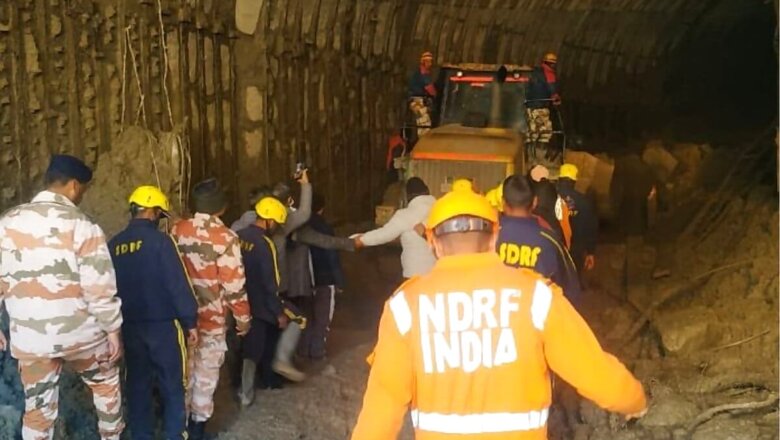
views
The Uttarakhand disaster of February yet again reminds us of the risks mountain states in India face due to their fragility. The breaking of the glacier at high altitudes in remote locations is largely caused by the possibility of an avalanche, landslide or an earthquake or because of climatic factors. It is believed that a combination of factors was at play during this incident, given the breaking of a rock that fell into the glacier that was already weakened and took the form of a glacial flood. There is not enough information on what must have caused the rock to break. Was it a decline in the glacial mass that was holding it till now? Ideally, a thorough investigation is needed to better understand the causes as the implications of such incidents to people and the environment are large. Also to conclude that such incidences will always have a combination of factors serving as a cause of occurrence and ideally there is no single factor. With the climate warming in these locations and the glaciers impacted, there is reason enough to be concerned about the weakening of the glaciers and the formation of lakes in some cases that may take the form of floods. At risk are all development and settlements.
So, to avoid further tragedies that may strike, corrective actions are needed to be put in place. A strong monitoring and surveillance system is needed. While it may not be feasible to monitor all the glaciers in the Himalayan system, the call of the day is to first use crude methods to identify where all lakes have been formed and are in a critical situation that may lead to a flood to drain them out.
Whatever information is currently being conveyed by the meteorological authorities to the district administration needs to be in clear practical terms. Agencies are needed that interpret the information to understand what percentage of power sources, habitations are likely to be affected in case of a flash flood or a flood in a location. In the 2013 Kedarnath tragedy, it would be recalled that the information on the flood was conveyed to the administration in terms of an extreme precipitation event but not the relevance on the ground. In contrast, in Cyclone Phailin in the same year due to the early warning system in place and over 1 million persons evacuated, the number of deaths was just 23 by official figures. We do understand that we have strong modelling systems for cyclones and a Cyclone Warning Centre which has been providing cyclone forecasts quite effectively and has been resulting in timely action and that these are different forms of disasters. However, it drives home the fact that centres of excellence are needed and should be identified and tasked with the job for related R&D and information on the risks.
Earlier this year, TERI completed a study for the state of Uttarakhand that was supported by the World Bank in coordination with the department of disaster management, Uttarakhand, indicating the risks for the state, including those related to the weakening of glaciers and mountain systems and had helped identify gaps and areas of interventions. One of the roadmaps for implementation included the need for early warning systems. Effective early warning systems are critical in reducing the impacts on society, particularly mortality and morbidity. Information for emergency response and meaningful action needs to reach the local level at lightning speed. Standard operating protocols should be framed for all individuals and communities with regard to various kinds of disasters so that before relief reaches, the community is self-organised.
Disaster management per se is now much more organised in the country since the National Disaster Management Authority was set up in 2005. A whole institutional mechanism now exists for relief and rehabilitation with the national and state disaster relief forces coming into action post an event. Elaborate lists of volunteers are maintained in each district that can be pressed into service at a moment’s notice. However, the integration with other sectors such as health is a huge blind spot. Effective triage also is a major issue. After survivors are rescued, often the most able-bodied reach the hospital first, leaving scarce resources for those who need it. Telemedicine is emerging as a crucial option for understaffed far-flung areas. However, the civil administration has to work on more helipads to cover the golden hour of 150-200 km for the most severely injured. Finally, the location of the hospital is critical since the surest way to ensure a disaster on top of a disaster is by not ensuring a disaster-resilient health facility.
We need a strong network of institutions to help deliver the above and each institution has to be playing its role effectively to counter the massive effects of the disasters that may strike. A remark made by a professor from HNB Garhwal University on the lack of effective action is that scientists are researchers who recommend these actions are not involved in the implementation process. There is a need to develop joint teams by government departments with institutions including centres of excellence to improve the implementation process of the actions. TERI is also assisting the state department of environment and the climate change directorate in the revision process of the state action plan on climate change and the state authorities and TERI both as a huge opportunity to build on some of these elements for implementation. We do hope that the impact of further disasters and tragedies are reduced and effective action is deployed.
Read all the Latest News, Breaking News and Coronavirus News here

















Comments
0 comment